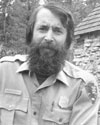 |
| Park Ranger Margaret Anderson |
The past 12 months have been an extremely sad time for law enforcement officers nationwide. It has been especially so for the extraordinary men and women whose mission is to keep safe all of America's national parks and the citizens who visit them.
Since its founding in 1916, the National Park Service has lost a total of 40 law enforcement officers in the line of duty in its two distinct agencies: The National Park Service (NPS) and the United States Park Police (USPP). Almost half those total deaths (17 of the 40) have occurred since 1990, and, tragically, 10% of the total deaths have happened in the past 12 months alone with four park LEOs being killed in the line of duty:
 |
| Sergeant Michael Boehm |
- On January 29, 2011, Park Ranger Chris Nickel (NPS) died while on a backcountry patrol in Hovenweep National Monument, Utah
- On February 24, 2011, Park Ranger Julie Weir (NPS) was killed in an automobile accident in Nebraska while on official travel from Independence National Historic Park, Pennsylvania, to Yosemite National Park, California
- On December 16, 2011, Sergeant Michael Boehm (USPP) suffered a fatal heart attack while responding to assist a man who had jumped from a bridge in Washington, DC.
- On January 1, 2012, Park Ranger Margaret Anderson (NPS) was shot and killed while attempting to stop a vehicle in Mount Rainier National Park, Washington.
The remote locations and ruggedness of many national parks put park rangers at a unique disadvantage when they encounter danger. Assuming they even have communications with dispatchers, their backup may be hours or even days away if they get injured or wounded.
 |
| Park Ranger Randy Morgenson |
Not all dangers faced by park LEOs occur in rural areas, however. The United States Park Police are tasked with protecting national parks and monuments located in and around the urban areas of Washington, DC, Philadelphia, New York City, and San Francisco. In a unique jurisdictional setup, the USPP don't only protect the parkland in Washington, DC, but share concurrent jurisdiction throughout the entire city. In fact, the very first park LEO killed in the line of duty was a member of the USPP. On November 12, 1923, Officer William Allen was electrocuted when he picked up a radio wire that was being installed on a home in Washington, DC, illegally.
The next time you visit a national park and encounter a park ranger or park police officer, be sure to thank them for keeping you safe. As seen in recent times, these park-based crime fighters have suffered more than their fare share of danger.
Author's note: This article addresses the dangers faced by law enforcement officers of the National Park Service and the United States Park Police. A follow up article will be written in the future highlighting the service and sacrifice suffered by local, state, and other federal parks / recreation law enforcement agencies.
